
Franconia is a region of Germany, characterised by its culture and East Franconian dialect . Franconia is made up of the three Regierungsbezirke of Lower, Middle and Upper Franconia in Bavaria, the adjacent, Franconian-speaking, South Thuringia, south of the Thuringian Forest—which constitutes the language boundary between Franconian and Thuringian—and the eastern parts of Heilbronn-Franconia in Baden-Württemberg.
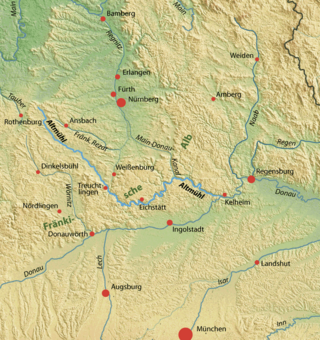
The Altmühl is a river in Bavaria, Germany. It is a left tributary of the river Danube and is approximately 230 kilometres (140 mi) long.

Kelheim is a town and municipality in Bavaria, Germany. It is the capital of the district Kelheim and is situated at the confluence of the rivers Altmühl and Danube. Kelheim has a population of around 16,750 (2020).

The Befreiungshalle is a neoclassical monument on the Michelsberg hill above the town of Kelheim in Bavaria, Germany. It stands upstream of Regensburg on the river Danube at the confluence of the Danube and the Altmühl, i.e. the Rhine–Main–Danube Canal. It is just downstream of the Danube Gorge, towering above its lower end. It was commissioned by King Ludwig I of Bavaria to commemorate the victory over Napoleon in the Befreiungskriege of 1813–1815.
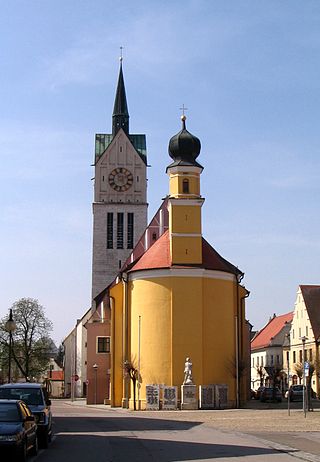
Neustadt an der Donau is a town in Lower Bavaria on the Danube in Bavaria, Germany. Lying on the western border of Landkreis Kelheim, Neustadt is primarily known for the thermal spa Bad Gögging. Neustadt had a population of 12,753 as of December 31, 2003.

Weltenburg Abbey is a Benedictine monastery in Weltenburg near Kelheim on the Danube in Bavaria, Germany.

The European Diploma of Protected Areas, established in 1965, is a diploma awarded by the Council of Europe to protected areas of exceptional European conservational interest. It is awarded for a five-year period at a time and is renewable. Over 60 areas in 23 states have received the award so far.
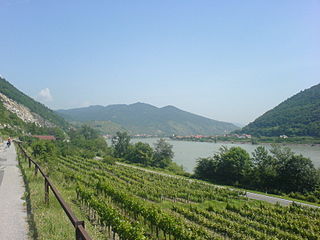
EuroVelo 6 (EV6), named the "Rivers Route", is a EuroVelo long-distance cycling route that runs along 3,653 km (2,270 mi) some of Europe's major rivers, including much of the Loire, some of the Saône, a short section of the upper Rhine and almost the entire length of Europe’s second longest river, the Danube — from the Atlantic coast of France to the city of Constanța on the Black Sea.

The Dreisesselberg is a mountain in Bavaria, Germany, in the Bavarian Forest that is 1,333 metres high.
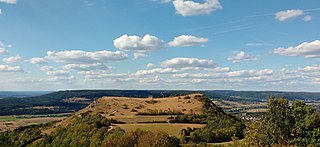
The Ehrenbürg is a double-peaked butte on the edge of the Franconian Jura in Bavaria, Germany. It is in the district of Forchheim in Upper Franconia, in the municipalities of Kirchehrenbach, Leutenbach and Wiesenthau. The north peak is the 513.9 m Walberla, the south peak the 531.7 m Rodenstein. The hill is popularly known as the Walberla.
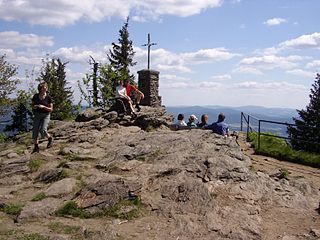
The Großer Falkenstein or Great Falkenstein, is a mountain, 1,315 metres (4,314 ft) high, in the Bavarian Forest about five kilometres southeast of Bayerisch Eisenstein in the Falkenstein-Rachel region of the Bavarian Forest National Park.

The Osser is a mountain on the border between Germany and the Czech Republic, in the Bavarian Forest and Bohemian Forest and which belongs to the Kunisch Mountains.
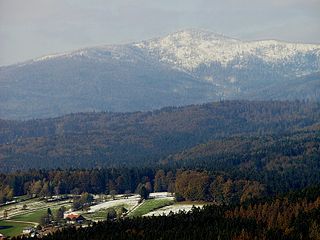
The Großer Rachel or Great Rachel is a mountain, 1,452 m above sea level (NHN); it is the second highest summit in the Bavarian Forest and Bohemian Forest after the Großer Arber and the highest mountain in the Bavarian Forest National Park. Together with the Kleiner Rachel or Little Rachel, 900 metres to the northwest, it forms the mountain of Rachel.

Lauter is a river of Bavaria, Germany. It is a right tributary of the Itz in Coburg.
The Lattengebirge, also sometimes called the Latten Mountains, are a mountain range up to 1,738 m above sea level (NN) in the county of Berchtesgadener Land in the German state of Bavaria. They form a subgroup of the Berchtesgaden Alps and forms the northern end of its parent range.

The Veldenstein Forest lies in the east of the Franconian Switzerland-Veldenstein Forest Nature Park between the towns of Pegnitz and Plech.

The Pfahl is a 150-kilometre-long quartz vein that runs through the northeastern Bavarian Forest in Germany. From a geomorphological point of view, it represents a residual ridge that has been formed by weathering and erosion over millions of years.
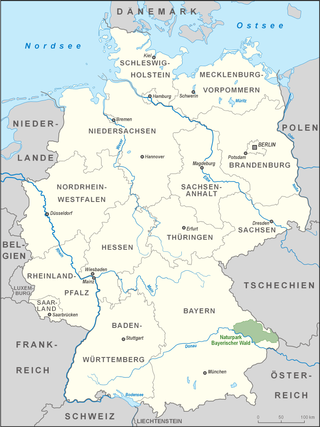
The Bavarian Forest Nature Park covers an area north of the Danube as far as the border ridge with the Czech Republic. Its sponsor organisation is the Naturpark Bayerischer Wald whose head office is in Zwiesel, Bavaria. It was established in 1967 and is thus the oldest nature park in Bavaria.

The Buchberger Leite is a gorge near Hohenau in the Lower Bavarian county of Freyung-Grafenau in Bavaria.
The Bärental is a small, 3.7 km long left-side valley of the Weismain Valley funnel within the Weismain-Alb region. It is situated entirely within the town of Weismain in the Lichtenfels district of Bavaria. This valley is located in the northernmost region of the Franconian Alb and is traversed by the Krassach River. Within the valley, there are 16 inhabitants, including the village of Krassach, 66 people. The three inhabited settlements are Herbstmühle, Krassacher Mühle, and Krassach. The valley holds appeal for hikers and is situated entirely within the nature park of Franconian Switzerland Veldensteiner Forest.


























